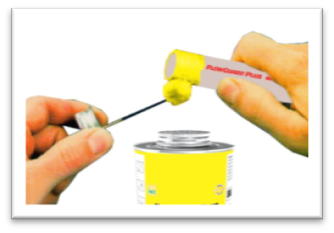
The Science of Solvent Cement Welding
In the ever-evolving landscape of piping systems, CPVC has gained significant traction, particularly in Domestic plumbing applications . CPVC is inherently an inert polymer and doesn’t react to acids, bases, salts, aliphatic hydrocarbons and chlorine. This is one of the reasons why CPVC becomes one of the preferred choices in domestic plumbing applications. Among the various joining methods, such as flanging, threading, and mechanical joining, solvent cement stands out for its quick application, ease of use, and reliable results. This blog will emphasis the science behind CPVC solvent cement welding & how it works to provide successful installations.
What is CPVC Solvent Cement?
CPVC solvent cement is made up of CPVC resin, stabilizers and fillers dissolved in a cocktail of solvents. These solvents serve two purposes:
- Dissolve the CPVC resin.
- Prepare the surface of the pipe and fitting.
Understand What is Solvent Welding
The solvent welded connection in CPVC pipe and fittings is an important link in installation. It can mean the success or failure of the system as a whole. Accordingly, it requires the same professional care and attention that is given to other components of the system.
Solvent cement welding is a fast, easy & reliable installation process that uses solvents and CPVC resin to chemically fuse the pipe and fitting together at the molecular level. In the end, using solvent cement doesn’t just adhere two pieces together—it creates one continuous piece of plastic. The joint becomes the strongest part of a piping system.
Upon application, the solvents effectively soften the top surface of pipe & inner surface fittings, loosening their molecular structure.
The pipe is then inserted into the fitting & given a quarter/half turn to ensure even distribution of solvent cement throughout the joint. Fusion occurs at the joint & becomes a homogeneous fixture or a double layered surface.
The CPVC resin in solvent cement fill in any gaps if exists. (its the same resin which is used for pipe & fitting compounds mfg.)
The entire process is also termed as Cold Fusion Welding. Preserve its properties, guarding against heat and oxidation, which can degrade the solution, thereby extending its shelf life.



Its not Glueing, It’s Fusion Joining
We often term CPVC solvent Cement as a glue or adhesive. Although, both accomplish the immediate goal of joining two surfaces the chemistries are actually very different.
A glue or an adhesive works by bonding two surfaces Part A on one side to Part B on another side (refer Image i) , in essence it works as a bridge. If the two parts comes in direct contact with each other, there will be no glue or adhesive, subsequently leading to debonding. (Here, the glue is the only medium of bonding)
In comparison, CPVC solvent cement welding doesn't allow any space in between. Rather a good bonding will happen only when majority of Part A & B fuses together. (refer Image ii)
The major observations in Solvent Cement welding is although two substrates have fused into each other, there is nothing in between the two substrates.


Image i Image ii
Factors That Affect CPVC Solvent Cement Weld Strength
To consistently get good joints, the following points should be maintained:
- Post application of solvent cement, joining surfaces must be softened and made semifluid.
- Optimum solvent cement must be applied to fill gap between pipe and fitting.
- Assembly of pipe and fittings must be made while the surfaces are still wet and cement is still fluid.
- Joint strength develops as the cement dries. In the tight part of the joint, the surfaces will tend to fuse together; in the loose part, the cement will penetrate to fuse both surfaces.
- In certain situations, especially in higher dia. materials, it is necessary to use a primer. A suitable primer will usually penetrate and soften the surfaces more quickly than cement alone, ensuring proper welding.
- It's always recommended to have dry fit application of pipe and fittings before cementing. For a proper interference fit, fitting should get inserted end of pipe easily but also needs to become tight about 1/3 to 2/3 on the way on. Too tight a fit is also not desirable.
- Cementing: Its mandatory to stir or shake the solvent cement can before using. An optimum, even layer of cement needs to be applied to the pipe-end equal to the depth of the fitting socket.
- While cement is still wet, assemble the pipe and fittings. If not completely wet, recoat parts before assembly. If cement coatings have hardened, cut pipe, dispose of fitting and start afresh with a new fitting. Do not assemble partially cured surfaces.
- While inserting pipe in fittings, its recommended to twist pipe ¼ to ½ turn until reaching socket bottom. Do not continue to rotate after the pipe has reached the socket bottom.
- Hold the pipe and fitting together for a minimum of 30 seconds to eliminate movement or pushout.
- Check for a clear bid formation of around the joint, this is assurance of perfect joint.
- Handle newly assembled joints carefully until initial set has taken place
Cure Time of Solvent Cement
Curing refers to the process wherein the solvent cement evaporates, and the material surface hardens, thus fusing the two pieces together. Generally, CPVC solvent cement curing time depends on various factors like, size of pipe & fittings, atmospheric temperature & relative humidity.
Recommended cure times are shown as below:

FAQs:
1. What Precautions do we need to take while doing solvent cementing?
- Avoid prolonged breathing of solvent vapors.
- When pipes and fittings are being joined in enclosed area, the use of ventilating devices are advised.
- Keep cements, primers and cleaners away from all the sources of ignition, heat, sparks and open flame.
- Keep containers of cements, primers and cleaners tightly closed except when the product is being used.
- Dispose of all rags used with solvents in a proper outdoor waste receptacle.
- Avoid eye & skin contact. In case of eye contact, flush with plenty of water for 15 minutes & contact a physician.
2. Can we use UPVC Solvent Cement in CPVC joining.?
UPVC solvent Cement can’t be used while joining CPVC because UPVC Cement uses PVC resins with a lower cell class than CPVC, it is unable to handle the operating parameters of a CPVC system and should never be used with CPVC.
3. What is the ideal shelf life of CPVC solvent Cement?
CPVC solvent cement are ideally formulated to have a Shelf life of two years. Cans are usually marked with manufacturing dates. Good CPVC solvent cement should have the flow consistency like honey with no undissolved materials. Expired cement will often change colour or begins to thicken and become jelly-like. When this occurs, the cement must be thrown away. Hence its always recommended to conduct a drip test before using the solvent cement.

Prasenjit Misra
Prasenjit Misra, an accomplished professional, having extensive exposure in plumbing field, currently holds the position of Lead Demand Creation & Business Development of TempRite South Asia division at Lubrizol India.
